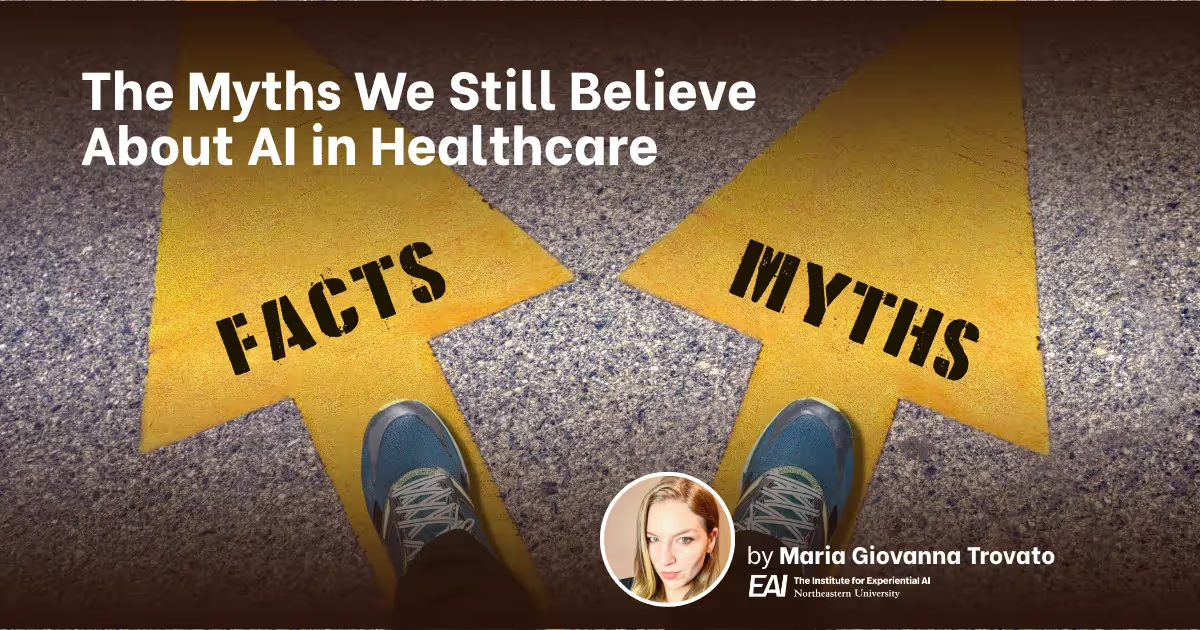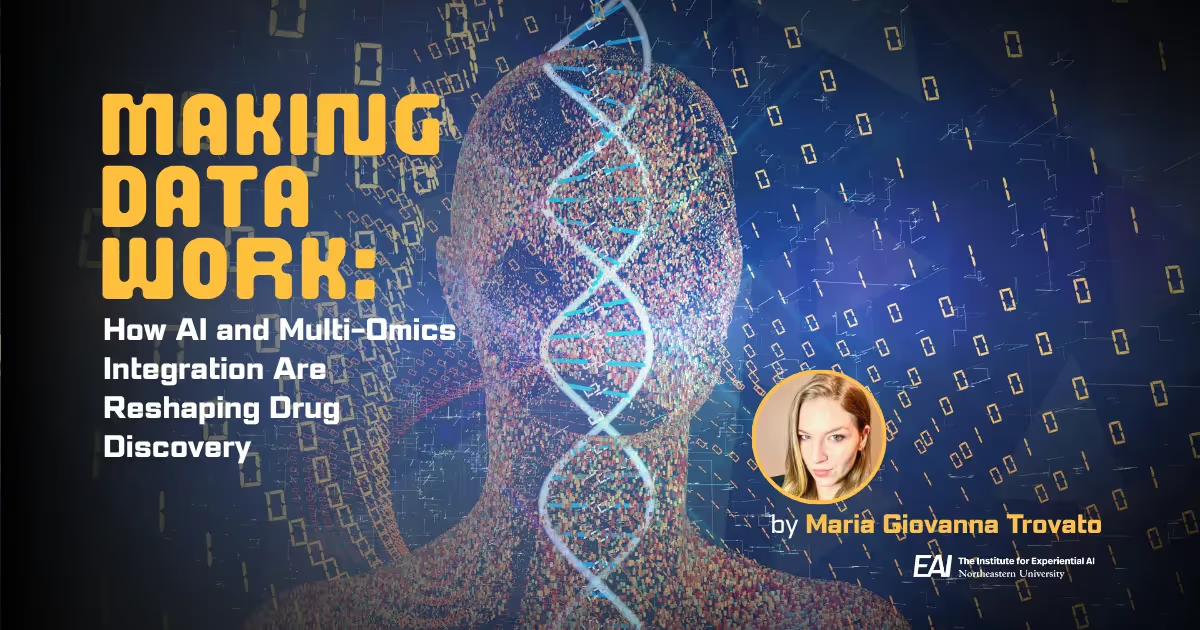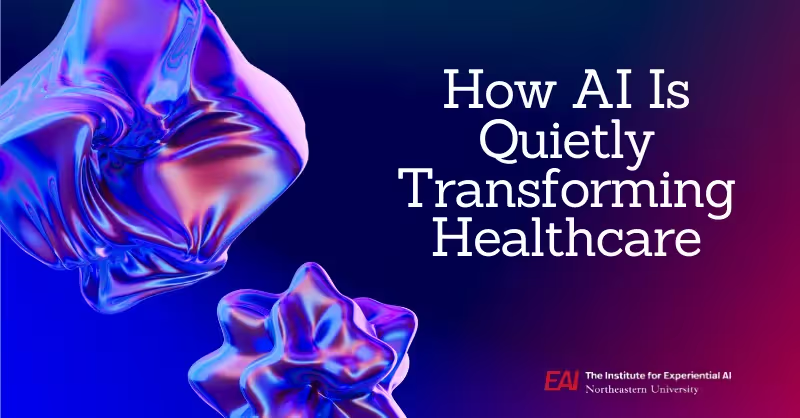The Myths We Still Believe About AI in Healthcare

AI will replace humans?
AI is always objective?
These myths continue to circulate, even in the most well-funded, tech-forward healthcare environments[1]. And despite the rapid evolution of tools and investment in AI, misconceptions remain widespread to this day, particularly regarding the reliability, explainability, and scope of AI applications in clinical practice[2]. But if you've ever actually worked with AI—in research, in diagnostics, or even in streamlining clinical workflows—the truth is more nuanced. And much more human.
Myth 1: AI Will Replace Experts
No, it won’t. Not in the real world, and not in healthcare.
Despite headlines about diagnostic accuracy and model performance, clinicians aren’t going anywhere. In fact, most AI systems that make it to deployment are still highly dependent on human interpretation, feedback, and contextual judgment.
Take the example of radiology: AI was predicted to replace radiologists, but it instead serves as a powerful support tool—triaging, flagging anomalies, and improving throughput—but only when used alongside expert interpretation[3]. In digital pathology, where I have worked from wet lab to AI-driven R&D, the true breakthroughs occurred when clinicians shaped both the design and the deployment of these Tools[4].
Over the years, I've worked side-by-side with physicians, clinical researchers, hospital IT teams, and translational scientists to support AI-driven clinical decision tools. Whether the task was integrating real-world data into electronic medical records or building tools to streamline patient stratification, one thing was consistent: the model is only useful if a human says, "Yes, this makes sense."
You can have the best performing model in the world, but the feedback loop—the iterative exchange between expert and machine—is what makes it useful. I’ve seen clinicians flag model errors in anomaly detection tools, challenge results from auto-summarization platforms, and override triage recommendations based on subtle patient factors that no model could ever infer from structured data alone.
If there’s one thing the past few years have made clear, it’s this: AI works best when it amplifies human expertise—not when it tries to replace it. And that’s still true in 2025.
Here are just a few real-world cases where human judgment made all the difference:
- In 2020, a Google Health AI model for breast cancer screening showed impressive accuracy—until it underperformed in UK-based clinical settings where the data environment was different. Human readers caught key misses[5].
- IBM Watson for Oncology, once touted as a breakthrough, failed in multiple real-world deployments because it didn’t align with local clinical practices. Doctors rejected many of its recommendations[6].
- Across multiple real-world deployments, AI diagnostic tools performed best when clinicians were actively involved in their design and implementation. Where end users weren’t consulted, systems faced skepticism, lower adoption, and inconsistent outcomes. When left to AI alone? The error rate rose[7].

Myth 2: AI Is Objective by Design
Let’s be clear: AI is not objective. It reflects the biases of its data, its creators, and the systems it’s trained on.
AI doesn’t interpret the world—it mirrors it. And that mirror is often cracked.
In oncology, models trained primarily on data from white, Western populations have repeatedly shown reduced accuracy when applied to underrepresented groups. A 2024 study highlighted disparities in skin lesion classification AI models, with significantly lower performance in darker-skinned patients[8].
In neurology, early detection tools for Alzheimer’s and Parkinson’s have struggled to generalize because training datasets skew toward certain imaging protocols or early-onset subtypes, missing the broader clinical presentation[9].
And in infectious disease? Models built on COVID-19 data from early outbreaks in China or Italy failed to predict trends in the U.S. South because they couldn’t account for demographic, social, or healthcare access differences[10].
The problem isn’t the algorithm. It’s the assumption that data is truth. But as every researcher knows: "Garbage in, garbage out" still holds. Especially when the garbage is invisible.
Toward Responsible Design: Expert-in-the-Loop
I always say: it’s not just a human-in-the-loop that we need. It’s an expert in the loop.
Responsible AI design in healthcare means putting those with deep clinical, biological, and contextual knowledge directly into the development cycle. It means creating systems that clinicians can question, challenge, and refine. It means building platforms that surface uncertainty, that highlight the boundaries of what the model knows.
Behind every AI success story I’ve seen, there’s been an interdisciplinary team: data scientists willing to learn clinical nuance, physicians willing to think algorithmically, project managers patient enough to translate between worlds. These are the teams that work. These are the teams that learn.
Transparency isn’t just ethical. It’s functional. It’s the foundation for trust.
Regulatory Momentum
Frameworks are finally catching up:
- The FDA’s Good Machine Learning Practice (GMLP) guidelines emphasize human oversight, model transparency, and continuous learning[11].
- The EU AI Act mandates risk classification and explainability for high-risk AI systems like those used in healthcare[12].
- The IMDRF (International Medical Device Regulators Forum) is aligning global standards for AI-enabled medical devices to ensure traceability and post-market monitoring[13].
These aren’t just bureaucratic steps. They’re formalizing the idea that AI should support, not supplant, expertise.
Conclusion
AI isn’t magic. And it isn’t neutral. But when built responsibly, and guided by people who know what they’re doing, it can amplify some of the best in us.
The future isn’t AI versus humans. It’s AI with experts. And if we do it right, we won’t just speed up healthcare—we’ll make it smarter, safer, and more human.
References
1.Rajkomar, A., Dean, J., & Kohane, I. (2019). Machine Learning in Medicine. New England Journal of Medicine, 380(14), 1347–1358. https://doi.org/10.1056/NEJMra1814259
2. Jackson, G. P., & Shortliffe, E. H. (2025). Understanding the evidence for artificial intelligence in healthcare. BMJ Quality & Safety. https://doi.org/10.1136/bmjqs-2025-018559
3. Smith, M. S. (2025, June). AI isn't replacing radiologists. Instead, they're using it to tackle time-sucking administrative tasks. Business Insider. https://www.businessinsider.com/radiology-embraces-generative-ai-to-streamline-productivity-2025-6
4. Zarella, M. D., McClintock, D. S., Batra, H., Gullapalli, R. R., Valante, M., Tan, V. O., Dayal, S., Oh, K. S., Lara, H., Garcia, C. A., & Abels, E. (2023). Artificial intelligence and digital pathology: Clinical promise and deployment considerations. Journal of Medical Imaging, 10(5), 051802. https://doi.org/10.1117/1.JMI.10.5.051802
5. Robbins, R. (2020, January 1). Google's AI breast cancer screening model is impressive — but struggles with real-world data. STAT News. https://www.statnews.com/2020/01/01/google-ai-breast-cancer-study/
6. Dolfing, H. (2024, December 18). Case study: Why IBM Watson for Oncology failed. Henrico Dolfing. https://www.henricodolfing.com/2024/12/case-study-ibm-watson-for-oncology-failure.html
7. Kuo, R. Y. L., Freethy, A., Smith, J., Hill, R., Joanna, C., Jerome, D., Harriss, E., Collins, G. S., Tutton, E., & Furniss, D. (2024). Stakeholder perspectives towards diagnostic artificial intelligence: A co-produced qualitative evidence synthesis. eClinicalMedicine, 79, 102555. https://doi.org/10.1016/j.eclinm.2024.102555
8. Groh, M., Badri, O., Daneshjou, R., Koochek, A., Harris, C., Soenksen, L. R., Doraiswamy, P. M., & Picard, R. (2024). Deep learning-aided decision support for diagnosis of skin disease across skin tones. Nature Medicine, 30, 573–583. https://pubmed.ncbi.nlm.nih.gov/38317019/
9. Ali, S. S. A., Memon, K., Yahya, N., & Khan, S. (2025). Deep learning frameworks for MRI-based diagnosis of neurological disorders: A systematic review and meta-analysis. Artificial Intelligence Review, 58, Article 171. https://doi.org/10.1007/s10462-025-11146-5
10. Chharia, A., Jeevan, G., Jha, R. A., Liu, M., Berman, J. M., & Glorioso, C. (2024). Accuracy of US CDC COVID-19 forecasting models. Frontiers in Public Health, 12, 1359368. https://doi.org/10.3389/fpubh.2024.1359368
11. U.S. Food and Drug Administration. Good Machine Learning Practice for Medical Device Development: Guiding Principles. 2021. https://www.fda.gov/media/153486/download
12. an Kolfschooten, H., & van Oirschot, J. (2024). The EU Artificial Intelligence Act (2024): Implications for healthcare. The Lancet Digital Health. https://www.sciencedirect.com/science/article/pii/S0168851024001623?via%3Dihub
13. International Medical Device Regulators Forum (IMDRF). Artificial Intelligence Medical Devices (AIMDs) Working Group. 2022. https://www.imdrf.org/working-groups/artificial-intelligence-medical-devices




